Comets
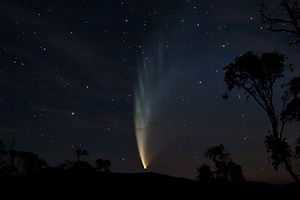
A comet is a small solar system body that has a solid icy nucleus. When near the Sun a comet can also have an extremely tenuous atmosphere called the coma which can grow into a large and bright tail.
Entities

Sungrazers
Still other comets have dangerously close orbits to the sun and dozens have been found in recent years by a solar observing spacecraft plummeting into our nearest star.
Comet Bennett 1970 II
The velocities of the cyan molecule as produced in the head of comet Bennett 1970 II have been measured.[1]
Comet Borrelly
"A typical comet nucleus has an albedo of 0.04.[2]"[3]
Comet C/2013 A1 Siding Spring
"A comet that flew close to Mars showered the red planet with fine cometary dust, according to observations by a trio of spacecraft."[4]
"Comet C/2013 A1 Siding Spring passed within 139,500 kilometres of the red planet on 19 October, the closest a comet has ever been seen to come to a planet without actually colliding with it. To avoid being damaged by the comet dust, all spacecraft orbiting Mars moved to the far side of the planet for 20 minutes while the comet dust was at its most intense, but this did not prevent them from studying the effects it had on Mars’ atmosphere."[4]
“They call this comet encounter a once-in-a-lifetime event, but it’s more like once in a million years.”[5]
"The European Space Agency’s Mars Express spacecraft detected an increase in electrons in Mars’ upper atmosphere, partly ionising it. This was attributed to fine cometary dust penetrating the atmosphere, which led to a meteor storm of thousands of meteors per hour. The increase in electrons led to the creation of a temporary new layer of charged particles in the ionosphere, which runs from an altitude of 120 kilometres to several hundred kilometres above. This is the first time such an event has been seen, even on Earth the extra density of electrons was measured to be five to ten times higher than normal by NASA’s Mars Reconnaissance Orbiter. Another NASA spacecraft, MAVEN, which also observed the new layer in the ionosphere, will monitor for any long-term events as it goes about its regular duties of studying Mars’ atmosphere."[4]
"MAVEN’s Imaging Ultraviolet Spectrograph was able to ascertain the species of ions that flooded into the ionosphere from the comet, the first time a comet that has come direct from the distant Oort Cloud has been sampled in this way. It detected the signal of magnesium, iron and sodium ions following the meteor shower, a signal that dominated Mars’ ultraviolet spectrum for hours afterwards, taking two days to dissipate."[4]
"The results show that dust from the comet, which has a nucleus two kilometres across, according to high resolution images from the Mars Reconnaissance Orbiter, had a dramatic effect on Mars’ atmosphere."[4]
“Observing the effects on Mars of the comet’s dust slamming into the upper atmosphere makes me very happy that we decided to put our spacecraft on the other side of Mars at the peak of the dust tail passage and out of harm’s way.”[6]
Comet 67P/Churyumov-Gerasimenko
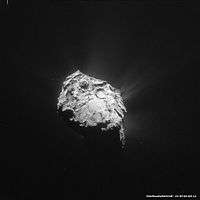
Comet Halley
“During the Halley Monitoring Program at La Silla from Feb.17 to Apr.17,1986 ... In the light of the neutral CN-radical a continuous formation and expansion of [cyan] gas-shells could be observed.”[7] “The gas-expansion velocity decreases with increasing heliocentric distance from 1 km/s in early March to 0.8 km/s in April.”[7]
17P/Holmes
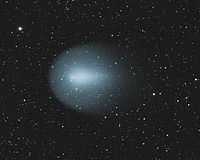
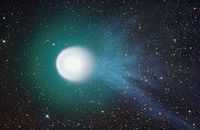
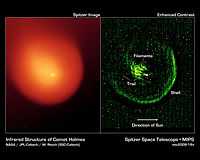
On Oct 23, 2007, J. A. Henríquez Santana in the Canary Islands and Ramón Naves in Barcelona noticed an impressive spectacle, a bright and large comet gleemed through the bright full moon in the constellation Perseus. This was not a new comet, yet it was a supposedly boring one. The comet 17P Holmes was supposed to be a meagre 17th magnitude, far too dim for most telescopes to even detect in the bright moonlight.
The comet had suddenly brightened a half a million times and was easily seen by the unaided eye. Such is the importance of keeping an eye out for changes in a known comets. Within days, the most powerful telescopes on the Earth (and the one above it, the Hubble Space Telescope) would be viewing it.
So I make it a daily ritual to check out and record as many details as I can about each viewable comet and like to be aware for new things while I'm at my telescope.
An extremely good web page for comets is Greg Crinklaw's Skyhound and by coincidence Holmes is coming out of the glare fo the sun. We should keep tabs on it!
In the second image pair, "NASA's Spitzer Space Telescope captured the picture on the left of comet Holmes in March 2008, five months after the comet suddenly erupted and brightened a millionfold overnight. The contrast of the picture has been enhanced on the right to show the anatomy of the comet."[8]
"Every six years, comet 17P/Holmes speeds away from Jupiter and heads inward toward the sun, traveling the same route typically without incident. However, twice in the last 116 years, in November 1892 and October 2007, comet Holmes mysteriously exploded as it approached the asteroid belt. Astronomers still do not know the cause of these eruptions."[8]
"Spitzer's infrared picture at left reveals fine dust particles that make up the outer shell, or coma, of the comet. The nucleus of the comet is within the bright whitish spot in the center, while the yellow area shows solid particles that were blown from the comet in the explosion. The comet is headed away from the sun, which lies beyond the right-hand side of the picture."[8]
"The contrast-enhanced picture on the right shows the comet's outer shell, and strange filaments, or streamers, of dust. The streamers and shell are a yet another mystery surrounding comet Holmes. Scientists had initially suspected that the streamers were small dust particles ejected from fragments of the nucleus, or from hyperactive jets on the nucleus, during the October 2007 explosion. If so, both the streamers and the shell should have shifted their orientation as the comet followed its orbit around the sun. Radiation pressure from the sun should have swept the material back and away from it. But pictures of comet Holmes taken by Spitzer over time show the streamers and shell in the same configuration, and not pointing away from the sun. The observations have left astronomers stumped."[8]
"The horizontal line seen in the contrast-enhanced picture is a trail of debris that travels along with the comet in its orbit."[8]
"The Spitzer picture was taken with the spacecraft's multiband imaging photometer at an infrared wavelength of 24 microns."[8]
Comet Kohoutek 1973 XII
The neutral cyan coma of comet Kohoutek 1973 XII is measured.[9]
Comet Lovejoy
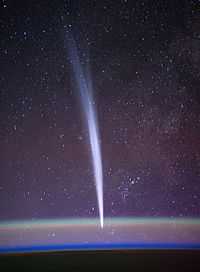
Comet Lulin
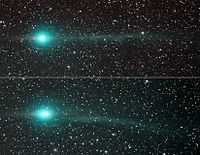
Shown at the right "Lulin's green color comes from the gases that make up its Jupiter-sized atmosphere. Jets spewing from the comet's nucleus contain cyanogen (CN: a poisonous gas found in many comets) and diatomic carbon (C2). Both substances glow green when illuminated by sunlight".[10]
Comet McNaught
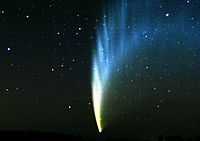
Comet PanSTARRS C/2012 K1

On the right is a visual image of comet PanSTARRS C/2012 K1.
"Now within the inner solar system, the icy body from the Oort cloud sports two tails, a lighter broad dust tail and crooked ion tail extending below and right. The comet's condensed greenish coma makes a nice contrast with the spiky yellowish background star above. NGC 3319 appears at the upper left of the frame that spans almost twice the apparent diameter of the full Moon."[11]
Comet Schwassmann-Wachmann I (P/SW-1)
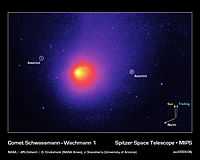
"NASA's new Spitzer Space Telescope has captured [the image right] of an unusual comet that experiences frequent outbursts, which produce abrupt changes in brightness. Periodic comet Schwassmann-Wachmann I (P/SW-1) has a nearly circular orbit just outside that of Jupiter, with an orbital period of 14.9 years. It is thought that the outbursts arise from the build-up of internal gas pressure as the heat of the Sun slowly evaporates frozen carbon dioxide and carbon monoxide beneath the blackened crust of the comet nucleus. When the internal pressure exceeds the strength of the overlying crust, a rupture occurs, and a burst of gas and dust fragments is ejected into space at speeds of 450 miles per hour (200 meters per second)."[12]
"This 24-micron image of P/SW-1 was obtained with Spitzer's multiband imaging photometer. The image shows thermal infrared emission from the dusty coma and tail of the comet. The nucleus of the comet is about 18 miles (30 kilometers) in diameter and is too small to be resolved by Spitzer. The micron-sized dust grains in the coma and tail stream out away from the Sun. The dust and gas comprising the comet's nucleus is part of the same primordial materials from which the Sun and planets were formed billions of years ago. The complex carbon-rich molecules they contain may have provided some of the raw materials from which life originated on Earth."[12]
"Schwassmann-Wachmann 1 is thought to be a member of a relatively new class of objects called "Centaurs," of which 45 objects are known. These are small icy bodies with orbits between those of Jupiter and Neptune. Astronomers believe that Centaurs are recent escapees from the Kuiper Belt, a zone of small bodies orbiting in a cloud at the distant reaches of the solar system."[12]
Comet Swan
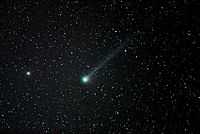
"Comet Swan recently made a swing through the inner solar and emerged in the evening sky. Astronomy enthusiast Ginger Mayfield recorded the blue-green color of the comet's nucleus and a tenuous tail in this composite created from multiple images taken on October 26 from Divide, Colorado."[13]
Comet West 1976 VI

The physical parameters of the neutral cyan coma of comet West (1975n) have been measured.[14]
Kuiper Belt
Occasionally inteferences with the large gas giants of our solar system (Jupiter and Saturn) will further alter their orbit. These comets commonly roam in an area called the Kuiper belt, that surrounds the last planet Neptune. The orbits of these comets vary highly from the diminuitive comet Encke (3 years) to the famed comet Halley seen only once maybe twice a lifetime (76 years).
Oort Cloud
Most of the comets lay at the distant reaches of our system in a hypothesized Oort cloud. At the very edge of the solar these comets orbit in very large loops around the distant reaches of our solar system. The passing of nearby stars, or other objects can alter their orbit, sending them speeding towards the inner reaches of our solar system. these comets typically retain very large orbits such that they will not return (once seen in the inner solar system) for many thousands of years.
Telescopes
"A comet seeker is a type of small telescope adapted especially to searching for comets: commonly of short focal length and large aperture, in order to secure the greatest brilliancy of light."[15]
Observing
Irregardless of where comets come from or go. Comets are a regular visitor the inner solar system. Because comets cannot be detected at the furthest reaches of our solar system, there is always the chance for a dramatic visit by a truly well-traveled visitor. Amatuer astronomers have been enthusiastic searchers for these cosmic visitor since the beginning of time and according to astronomical convention, whomever first finds the comets, has their name immortalized in the heavens.
Currently visible in a small scope (6" or less)
Comets visible during October 2008 (place any observations below and include time, date, location, and any observable features)
17P/Holmes: A morning comet near Cancer visible in binoculars
- Very good to see as it has not been widely seen yet, its brightness and location might be useful to report
C/2008 A1 (McNaught): An evening comet in Ophiuchus visible in binoculars
C/2006 W3 (Christensen): A evening comet in Cassiopeia visible in small telescopes
- * Tough comet in a smalltown sky (5.0magn); I see a spherical 3' glow with little condensation and no nucleus.--Jolie (254mm reflector at 79X at Fri Oct 24,08 2:45UTC)
- * Hazy conditions, and much light pollution. --mikeu (16" f/10 SCT with CCD on 2008-11-22T02:53:23 UTC)
C/2006 OF2 (Broughton): A morning comet in Camelopardalis visible in small telescopes
- * Dim but definite in a smalltown sky (5.0magn); spherical with some condensation and a very faint nucleus. --Jolie (254mm reflector at 79X at Fri Oct 24,08 5:55UTC)
19P/Schwassmann-Wachmann: A morning comet in Cancer visible in small telescopes
- good to keep a watch on as it had a tendency for outbursts
C/2008 J1 (Boattini): A far-northern evening comet in Camelopardalis visible in a 6-inch telescope
205P/Giacobini: An evening comet in Aquarius visible in a 6-inch telescope
See also
References
- ↑ I. N. Matveev (1982). "Determination of velocities of cyan molecule production in the head of comet Bennett 1970 II". Kometnyj Tsirkulyar (286).
- ↑ Robert Roy Britt (2001-11-29). "Comet Borrelly Puzzle: Darkest Object in the Solar System". Space.com. Retrieved 2012-09-01.
- ↑ "Albedo, In: Wikipedia". San Francisco, California: Wikimedia Foundation, Inc. April 24, 2013. Retrieved 2013-05-01.
- 1 2 3 4 5 Keith Cooper (10 November 2014). "Comet dust ionises Mars’ atmosphere". United Kingdom: Astronomy Now. Retrieved 2015-05-18.
- ↑ Nick Schneider (10 November 2014). "Comet dust ionises Mars’ atmosphere". United Kingdom: Astronomy Now. Retrieved 2015-05-18.
- ↑ Jim Green (10 November 2014). "Comet dust ionises Mars’ atmosphere". United Kingdom: Astronomy Now. Retrieved 2015-05-18.
- 1 2 Wolfhard Schlosser, Rita Schulz, Paul Koczet (1986). The cyan shells of Comet P/Halley, In: Proceedings of the 20th ESLAB Symposium on the Exploration of Halley's Comet. 3. European Space Agency. pp. 495-8. Bibcode: 1986ESASP.250c.495S.
- 1 2 3 4 5 6 W. Reach (October 10, 2008). "Anatomy of a Busted Comet". Pasadena, California, USA: NASA, JPL, California Institute of Technology. Retrieved 2012-11-26.
- ↑ RS Amirkhanov, KI Churyumov, Gorodetsij (1978). "Physical parameters of the neutral cyan coma of comet Kohoutek, 1973 XII.". Kometnyj Tsirkulyar (220).
- ↑ James A. Phillips (2009). "Green Comet Approaches Earth". National Aeronautics and Space Administration Science News. Retrieved 2012-05-05.
- ↑ Robert Nemiroff & Jerry Bonnell (6 June 2014). "Comet PanSTARRS with Galaxy". Greenbelt, Maryland USA: NASA/GSFC. Retrieved 2015-08-31.
- 1 2 3 Dale Cruikshank (December 18, 2003). "Comet Schwassmann-Wachmann 1". Pasadena, California, USA: NASA, JPL, California Institute of Technology. Retrieved 2012-11-26.
- ↑ Space Archive (November 4, 2006). "Comet Swan". SpaceArchive.com. Retrieved 2014-02-22.
- ↑ V. A. Oshchepkov, N. M. Shiper (1978). "Physical parameters of the neutral cyan coma of comet West (1975n)". Kometnyj Tsirkulyar (234).
- ↑ "Comet seeker, In: Wikipedia". San Francisco, California: Wikimedia Foundation, Inc. March 6, 2013. Retrieved 2014-01-03.
External links
| |
Educational level: this is a research resource. |
| |
Subject classification: this is an astronomy resource. |